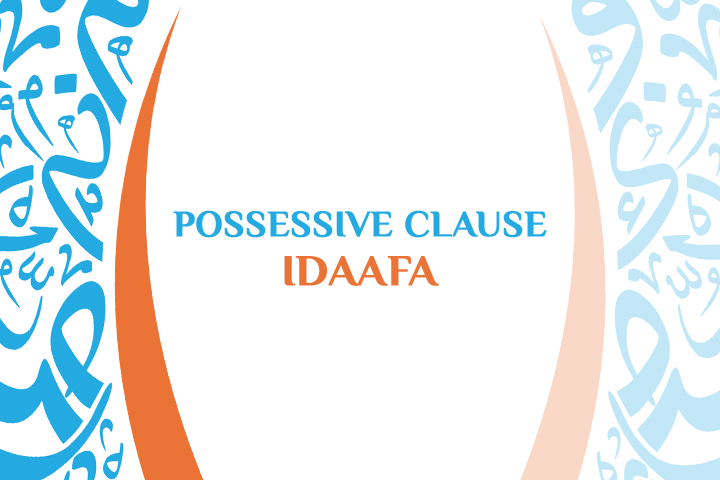Welcome to a core concept in Arabic grammar that will significantly boost your fluency: Idaafa Arabic! This unique grammatical structure, also known as the “construct state” or “genitive construction,” is the primary way to show possession or a close relationship between two or more nouns in Arabic. Often described as a possessive clause, mastering Idaafa is essential for expressing ownership, describing relationships, and forming natural-sounding Arabic sentences. Let’s delve into the elegant rules of idaafa Arabic and see how it works its magic!
What is Idaafa in Arabic (الإِضَافَة)?
In its simplest form, Idaafa is a grammatical construction where one noun (the “possessed” item) is directly followed by another noun (the “possessor” or the noun that describes the first noun). Think of it like saying “the book of the student” or “the student’s book” in English, but without needing a preposition like “of” or an apostrophe ‘s’.
The two main parts of an Idaafa Arabic construction are:
- (Al-Mudaf) المُضَاف : The first noun in the sequence. This is the item being possessed or described.
- (Al-Mudaf Ilayhi) المُضَاف إِلَيْهِ : The second noun in the sequence. This is the possessor or the noun that clarifies the first noun.
The Key Rules of Idaafa Arabic
Once you understand these simple rules, the abjad system becomes much clearer:
- No Definite Article (الـ) on the Mudaf: The first noun (Mudaf) cannot take the definite article (الـ). Even if the entire construct is meant to be definite (like “the student’s book”), only the Mudaf Ilayhi (the second noun) will carry the definite article.
- No Tanween on the Mudaf: The first noun (Mudaf) cannot have tanween (the -un, -an, -in endings) at the end. If it’s plural or dual, it will drop its final ‘ن’ (noon).
- Mudaf Ilayhi is Always in the Genitive Case: The second noun (Mudaf Ilayhi) is always in the genitive case (مَجْرُور – majrūr), meaning its ending will typically have a kasra (ـِ) or kasratayn (ـٍ) if indefinite, or will be affected by case endings for duals and sound masculine plurals.
- Adjectives Come After: Any adjective describing the Mudaf (the first noun) comes after the Mudaf Ilayhi (the second noun), and it will agree with the Mudaf in gender, number, and definiteness.
Examples of Idaafa Arabic: Seeing it in Action
Let’s illustrate the Idaafa structure with some common examples:
Simple Possession:
- The student’s book / The book of the student – كِتَابُ الطَّالِبِ (kitābu aṭ-ṭālibi)
- Mudaf (no Al-, no Tanween) – كِتَابُ (kitābu)
- Mudaf Ilayhi (definite, genitive case) – الطَّالِبِ (aṭ-ṭālibi)
- The manager’s house / The house of the manager – بَيْتُ الْمُدِيرِ (baytu al-mudīri)
- Mudaf – بَيْتُ (baytu)
- Mudaf Ilayhi – الْمُدِيرِ (al-mudīri)
Descriptive Relationship (not strict possession):
- Student of knowledge / Knowledge seeker – طَالِبُ الْعِلْمِ (ṭālibu al-ʿilmi)
- Mudaf – طَالِبُ (ṭālibu)
- Mudaf Ilayhi – الْعِلْمِ (al-ʿilmi)
- A cup of tea – كُوبُ شَايٍ (kūbu shāyin)
- Mudaf – كُوبُ (kūbu)
- Mudaf Ilayhi (indefinite, genitive case with tanween) – شَايٍ (shāyin)
Chains of Idaafa: You can even link multiple nouns in an Idaafa chain!
- The door of the manager’s house / The manager’s house’s door – بَابُ بَيْتِ الْمُدِيرِ (bābu bayti al-mudīri)
- Here, بَابُ is Mudaf to بَيْتِ, and بَيْتِ is Mudaf to الْمُدِيرِ. Only the very last noun (الْمُدِيرِ) takes the definite article and determines the definiteness of the whole chain.
Idaafa with Pronouns: Attaching Possession
You can also attach pronouns to the Mudaf to show possession. In this case, the Mudaf still doesn’t take Al- or Tanween, and the attached pronoun indicates the possessor.
- كِتَابِي (kitābī) – My book (كِتَاب + ـي)
- بَيْتُكَ (baytuka) – Your (masculine singular) house (بَيْت + ـكَ)
- سَيَّارَتُهَا (sayyāratuhā) – Her car (سَيَّارَة + ـهَا)
Why Mastering This Possessive Clause is Crucial
The Idaafa construction is incredibly common in both spoken and written Arabic. Mastering it is vital because:
- Essential for Expressing Possession: It’s the standard way to say “X’s Y” or “Y of X.”
- Unlocks Complex Descriptions: It allows you to create nuanced descriptive phrases (e.g., “head of the department,” “Minister of Foreign Affairs”).
- Sounds Natural: Correct use of idaafa Arabic makes your speech and writing sound much more natural and fluent.
- Avoids Ambiguity: It clarifies relationships between nouns where English might use prepositions or different phrasing.
Understanding the Idaafa system is a significant step towards unlocking the elegance and precision of Arabic grammar. It’s a testament to the language’s logical structure and its ability to convey complex relationships efficiently.
Ready to confidently express ownership and relationships in Arabic? Visit www.kaleela.com and download the Kaleela Arabic learning app today! Our comprehensive lessons provide clear explanations and engaging exercises to help you master Idaafa Arabic and all other essential aspects of the language. Start building your Arabic sentences with confidence!



